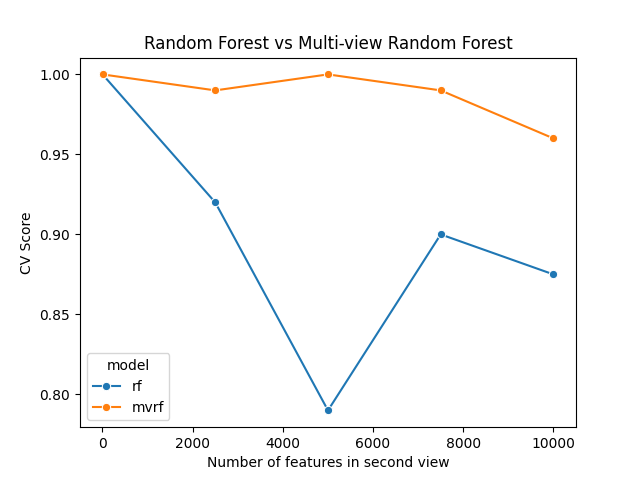Note
Go to the end to download the full example code
Analyze a multi-view dataset with a multi-view random forest#
An example using MultiViewRandomForestClassifier for high-dimensional
classification when there are multiple feature sets that are correlated with the
target variable, y. The multi-view random forest is a variant of the random forest
that samples from each feature set uniformly, instead of sampling from all features
uniformly. This is useful when there are multiple feature sets, and some feature sets
have vastly different dimensionality from others.
In this case, X is a matrix of shape (n_samples, n_features), where
n_features is the sum of the number of features in each feature set. If the multi-view
structure is known, then one can pass this to the multi-view random forest via the
feature_set_ends parameter.
For a visualization of how the multi-view splitter works, see Demonstrate and visualize a multi-view projection matrix for an axis-aligned tree.
from collections import defaultdict
import matplotlib.pyplot as plt
import numpy as np
import pandas as pd
import seaborn as sns
from sklearn.datasets import make_blobs
from sklearn.model_selection import cross_val_score
from sktree import MultiViewRandomForestClassifier, RandomForestClassifier
seed = 12345
rng = np.random.default_rng(seed)
def make_multiview_classification(
n_samples=100, n_features_1=5, n_features_2=1000, cluster_std=2.0, seed=None
):
rng = np.random.default_rng(seed=seed)
# Create a high-dimensional multiview dataset with a low-dimensional informative
# subspace in one view of the dataset.
X0_first, y0 = make_blobs(
n_samples=n_samples,
cluster_std=cluster_std,
n_features=n_features_1,
random_state=rng.integers(1, 10000),
centers=1,
)
X1_first, y1 = make_blobs(
n_samples=n_samples,
cluster_std=cluster_std,
n_features=n_features_1,
random_state=rng.integers(1, 10000),
centers=1,
)
y1[:] = 1
X0 = np.concatenate([X0_first, rng.standard_normal(size=(n_samples, n_features_2))], axis=1)
X1 = np.concatenate([X1_first, rng.standard_normal(size=(n_samples, n_features_2))], axis=1)
X = np.vstack((X0, X1))
y = np.hstack((y0, y1)).T
X = X + rng.standard_normal(size=X.shape)
return X, y
Simulate data#
We simulate a 2-view dataset with both views containing informative low-dimensional features. The first view has five dimensions, while the second view will vary from five to a thousand dimensions. The sample-size will be kept fixed, so we can compare the performance of regular Random forests with Multi-view Random Forests.
n_samples = 100
n_features_views = np.linspace(5, 10000, 5).astype(int)
datasets = []
for idx, n_features in enumerate(n_features_views):
X, y = make_multiview_classification(
n_samples=n_samples,
n_features_1=5,
n_features_2=n_features,
cluster_std=2.0,
seed=seed + idx,
)
datasets.append((X, y))
Fit Random Forest and Multi-view Random Forest#
Here, we fit both forests over all the datasets.
n_estimators = 100
n_jobs = -1
scores = defaultdict(list)
for idx, ((X, y), n_features) in enumerate(zip(datasets, n_features_views)):
feature_set_ends = np.array([5, n_features + 5])
rf = RandomForestClassifier(
n_estimators=n_estimators,
n_jobs=n_jobs,
random_state=seed,
)
mvrf = MultiViewRandomForestClassifier(
n_estimators=n_estimators,
n_jobs=n_jobs,
feature_set_ends=n_features_views,
random_state=seed,
)
# obtain the cross-validation score
rf_score = cross_val_score(rf, X, y, cv=2).mean()
mvrf_score = cross_val_score(mvrf, X, y, cv=2).mean()
scores["rf"].append(rf_score)
scores["mvrf"].append(mvrf_score)
Visualize scores and compare performance#
Now, we can compare the performance from the cross-validation experiment.
scores["n_features"] = n_features_views
df = pd.DataFrame(scores)
# melt the dataframe, to make it easier to plot
df = pd.melt(df, id_vars=["n_features"], var_name="model", value_name="score")
fig, ax = plt.subplots()
sns.lineplot(data=df, x="n_features", y="score", marker="o", hue="model", ax=ax)
ax.set_ylabel("CV Score")
ax.set_xlabel("Number of features in second view")
ax.set_title("Random Forest vs Multi-view Random Forest")
plt.show()

As we can see, the multi-view random forest outperforms the regular random forest as the number of features in the second view increases. This is because the multi-view random forest samples from each feature-set uniformly, while the regular random forest samples from all features uniformly. This is a key difference between the two forests.
Total running time of the script: (0 minutes 3.894 seconds)